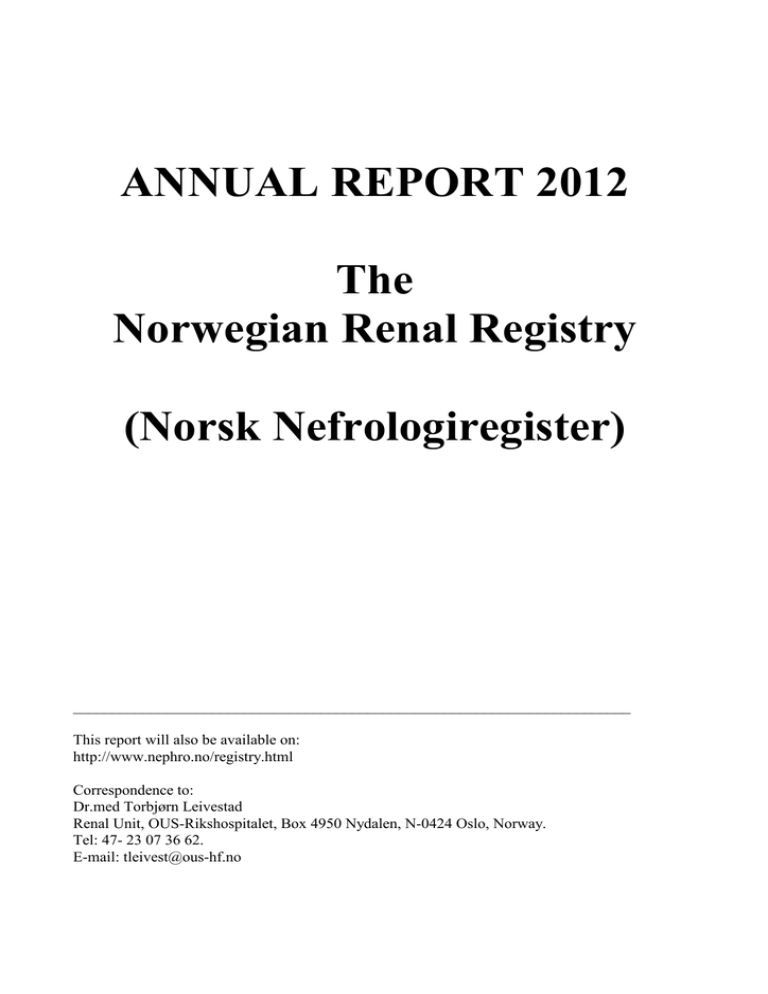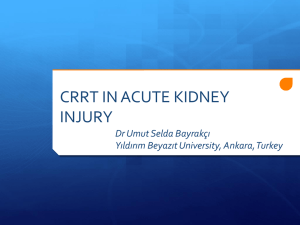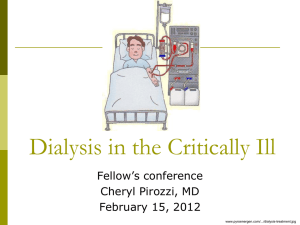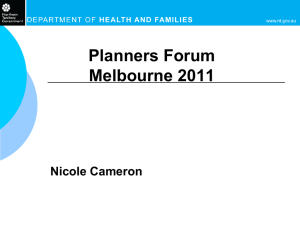ANNUAL REPORT 2012 The Norwegian Renal Registry (Norsk
advertisement

ANNUAL REPORT 2012 The Norwegian Renal Registry (Norsk Nefrologiregister) ________________________________________________________________________ This report will also be available on: http://www.nephro.no/registry.html Correspondence to: Dr.med Torbjørn Leivestad Renal Unit, OUS-Rikshospitalet, Box 4950 Nydalen, N-0424 Oslo, Norway. Tel: 47- 23 07 36 62. E-mail: tleivest@ous-hf.no Preface The Norwegian Renal Registry (Norsk Nefrologiregister) was formally constituted in 1994 as a collaboration between The Norwegian Renal Association (Norsk Nyremedisinsk Forening) and Oslo University Hospital-Rikshospitalet, with the latter as the formal owner. National data on renal replacement therapy (RRT) had been collected within The Renal Association since 1980 in a less formalised manner, and the transplant centre had stored data on transplanted patients since the late sixties. Further, Norwegian renal units had reported to the ERA-EDTA-registry since the late sixties. Since the mid-90ies, a process of transition from a pure epidemiological registry into a qualityoriented registry has progressed. With the present way of collecting and processing quality data, they cannot be collected in time to be included in the annual report, but selected data may be included in the next years report; others will be theme for quality-seminars and special reports. National organisation and policy Norway has 5.018 mill. inhabitants (July 2012) and 19 counties with populations ranging from 74.200 to 618.400. Each county, except one, has a central renal unit and some have two, further some have satellite units run in close contact with the central unit. There is only one transplant centre (two during 1963-83). Pre-transplant work-up, as well as post-transplant follow-up beyond 3 months, is handled by the county-centres. The centres, at present 24, are responsible for reporting data from day 1 on all patients receiving renal replacement therapy (RRT) for chronic renal failure within their area. Reporting is considered to be complete. Treatment of acute renal failure is not reported unless the failure turns out to be irreversible, in which case the whole treatment period is included. Minor changes of treatment modality, e.g. from HD to HDF or between CAPD and APD, are not reported. Similarly, temporary changes to HD for PD-patients are not reported. At intervals, crosschecking for unreported deaths is performed against official census data. Transplantation has always been considered the treatment of choice, if possible with a living related donor. Since 1984, also unrelated donors have been used. Acceptance criteria for transplantation have been wide, strict age limits have not been applied. Over time, an increasing number of non-transplantable patients have also been offered life-long dialysis. Incidence and prevalence calculations in this report are based on the national population data from July 2012, although this in some instances may be slightly misleading since population changes have not been uniform in all counties during the period. Incidence figures for 2012 During 2012 a total of 515 new patients (in 2011: 504) entered renal replacement therapy (RRT), i.e. 102.6 per mill. inhabitants. A majority of 329 (63.9 %) were males and 186 (36.1 %) females. Median age at start was 64.9 years, mean 63.1 years, ranging from 5.5 to 90.9 years. Tabulated by first mode of treatment, and age at start of treatment: < 15 15-24 25-34 35-44 45-54 55-64 65-74 75-84 85+ HD 1 5 14 23 41 75 86 89 15 PD 0 1 0 7 13 22 16 29 3 TX 3 2 4 7 19 21 17 2 0 Total 4 8 18 37 73 118 119 120 18 in % 0.8 1.6 3.5 7.2 14.2 22.9 23.1 23.3 3.5 Total 349 91 75 515 100 in % 67.8 17.7 14,6 100 2 At start of treatment, 348 (68 %) were considered by their nephrologist to be a potential candidate for transplantation, while 167 (32 %) were accepted for life-long dialysis (the latter constituting 40 % of those starting with HD and 31 % of those starting PD). Among patients starting dialysis in 2012, 79 % had been under control by the renal unit for at least four months, while 21 % were previously unknown. Incidence data: Changes 1980-2012 New patients in RRT by year of start & first mode of treatment 600 550 500 450 400 350 300 250 200 150 100 50 0 PD HD Tx 80 82 84 86 88 90 92 94 96 98 00 02 04 06 08 10 12 TL 05.13 Incidence data: Age at start Age of new patients in RRT Percentiles and range, by year of start 90 Max 80 95-perc. 70 60 Median 50 40 5-perc. 30 20 Min 10 0 80 84 88 92 96 00 04 08 12 TL 05.13 3 Since registration started in 1980 there has been a continuous shift in patient age. Both the maximum and the median age at start of RRT have increased. Also the 5-percentile and 95percentile values (i.e. including the majority of patients) have increased with a similar number of years. But also smaller children have been accepted; the youngest ever started PD in 2011 at age two days. Ten children below 15 years started RRT in 2011; after the peak number of 12 in 2005 we seem to be back to the previous range; between two and ten per year. Incidence data: Primary renal disease Glomerulonephritis Pyelo/interstitial nephr. Polycystic diseases Diabetic nephropathy Amyloidosis Vascular/hypertensive Immune/systemic Kidney tumour Myelomatosis Other defined Unknown N: 1980-89 35% 15% 10% 13% 6% 7% 5% 1% 2% 4% 3% 2018 1990-99 27% 11% 9% 11% 5% 21% 5% 1% 2% 4% 3% 3234 2000-04 18% 11% 9% 15% 3% 28% 4% 1% 3% 3% 4% 2149 2005-09 18% 10% 8% 16% 2% 31% 4% 2% 3% 4% 4% 2556 2010-11 16% 9% 7% 16% 2% 39% 4% 2% 1% 3% 3% 1013 2012 16% 8% 13% 17% 4% 30% 5% 1% 3% 2% 3% 515 The main change over time has been an increase of vascular/hypertensive nephropathy and a relative reduction of glomerulonephritis. Whether this only reflects changed coding practice or a true shift is not known. Amyloidosis also seems reduced over time. Diabetic nephropathy has contributed 10-17 % per year. In 2012, 30 were registered as having Type I and 55 as Type II diabetes, 82 patients with other types of primary renal disease were recorded as having diabetes as a co-morbid factor (all were Type II), thus 32 % of new patients were diabetics. The time from onset of diabetes to start of RRT differed considerably. For the 30 with Type I diabetes the mean time was 32.3 years, for the 55 with Type II diabetic nephropathy the mean time was 17.6 years. Type II diabetics judged to have a primary renal disease other than diabetic nephropathy in mean had 11.1 years of pre-RRT diabetes duration. Cardiovascular disease is often present at start of RRT. Coronary heart disease was reported in 131 (25%), 74 (14%) had anamnestic heart failure. Echo-verified left ventricular hypertrophy was reported in 114 (22%). Cerebrovascular disease was reported in 68 (13%) and peripheral atherosclerotic disease in 72 patients (14%) while 50 (10%) had chronic obstructive lung disease. Prevalence data: Status by 31.Dec. 2012. By the end of 2012, 4448 patients in Norway received renal replacement therapy, i.e. 886.5 per million inhabitants. This represents an increase of 119 patients or 2.7 % since 2011. Gender: 65.0 % males and 35.0 % females. Eleven patients were on home-HD (7 in 2011). Median age by the end of the year was 60.5 years, mean 58.6 years and range 1 - 95 years. 4 Tabulated by last mode of treatment, and age by end of 2012: < 15 15-24 25-34 35-44 45-54 55-64 65-74 75-84 HD 3 9 38 73 112 187 266 271 PD 1 1 2 11 21 38 36 71 TX 38 84 186 455 639 848 689 253 Total 42 94 227 539 772 1073 991 595 In % 0.9 2.1 5.1 12.1 17.4 24.1 22.3 13.4 85+ 85 14 16 115 2.6 Total 1044 196 3208 4448 100 in % 23.5 4.4 72.1 100 Renal replacement therapy in Norway Treatment mode prevalence: 1990, -95, 2000, -05, -10 &-12 N 3000 2976 2425 2500 HD 1963 2000 1560 1500 PD 1182 805 1000 156 220 196 Graft 119 526 1044 58 344 1002 39 500 3208 1990 1995 2000 2005 2010 2012 212 0 TL 05.13 Transplantation and waiting lists: A total of 299 renal transplants were performed at Oslo University Hospital Rikshospitalet in 2012, i.e. 60 per million inhabitants. In 81 (27%) the graft came from a living donor (LD), 23 of those were biologically unrelated to the recipient (19 were spouses). Among the LD-graft recipients 35 out of 73 first graft recipients were grafted pre-emptively, 3 out of 8 re-graft recipients did not receive dialysis. 218 patients received a deceased donor (DD) graft, 40 out of the 177 first graft recipients were pre-emptively transplanted (23 %), while 10 out of 41 had a regraft without entering dialysis. There were 250 first grafts (73 LD and 177 DD), 38 were second grafts (7 LD, 31 DD), seven third grafts (all DD) and four fourth grafts (1 LD, 3 DD). Simultaneous kidney + pancreas transplantation was performed in 17. In principle, transplantation is offered to all patients considered to profit from it, with no strict upper or lower age limit. The age of the 250 first-DD-graft recipients in 2012 ranged from 1 to 81 years, with a mean age of 54 y. Out of these, 28 % were above the age of 65 and 5 % were 75 or older. The 73 recipients of a first LD-graft were from 1 to 75 years, mean 47 y. Regraft recipients (n=49) were from 17 to 74 years, mean 50 y. 5 Renal replacement therapy in Norway Status by end of year - pats. pr mill. inhabitants In dialysis 250 225 200 175 150 125 New in RRT 100 Tx performed 75 50 Waiting list 25 0 1982 1985 1988 1991 1994 1997 2000 2003 2006 2009 2012 TL 05.13 By end 2012, 202 patients (40.5 per mill.) were on the active waiting list for a DD renal graft. This represented an increase of 12 patients (6 %) since 2011. Among those waiting by Dec.31, median time on the list was 6.0 months. 52 % had waited less than 6 months, 80 % less than one year and only 7 % more than two years. The 218 recipients given a DD-graft in 2012 had a median waiting time of 9 months and a maximum of 126 months at the time of grafting. Among the 1240 patients in dialysis treatment by Dec.31, 649 (52.3 %) were for various reasons not considered candidates for a new renal graft. New patients in 2012 – status at start of RRT. A total of 515 patients started RRT in 2012. Among the 349 starting haemodialysis, the access was via catheter in 249 patients (71%), while 29% had AV-fistula (100) as access. Status at start of RRT Total (n:515) HD (n:349) PD (n:91) Tx (n:75) Creatinine (mean) 617 µmol/l 652 615 458 eGFR (mean), (excl. children) 9.1 8.6 8.7 12.2 Albumin (mean) 36 g/L 34 39 44 Haemoglobin (mean) 10.6 g/dL 10.3 11.0 11.7 Haemoglobin - % <11 g/dL 57 % 66 % 41 % 32 % ESA use 47 % 43 % 57 % 41 % Active D vitamin use 60 % 54 % 77 % 62 % Statin use 53% 52 % 59 % 49 % Not on antihypertensive drugs 12 % 14 % 7% 7% Using >2 antihypertensive drugs 51 % 49 % 62 % 47 % As might be anticipated, pre-emptively transplanted patients had a somewhat lower serum creatinine, thus higher GFR, and a higher haemoglobin and albumin than those starting dialysis. Among patients known less than four months, 77 % had haemoglobin <11 g/dL. 6 While pre-emptive transplantation is considered the best initial RRT, HD by catheter may be considered the poorest alternative. In the following figure, individual centres are ranged by the proportion starting with catheter (NORW = country) from “best” to “poorest”. Admittedly, small centres and centres not offering PD are disadvantaged in such comparisons. Initial RRT 2012, by centre. 100 % 90 % 80 % 70 % 60 % 50 % 40 % 30 % 20 % 10 % 0% HDCath HD-AVF PD Leva RH Stav KrsS Hauk KrsN Førd Trom Dram Hars AHUS Bodø Åles Aren Lill Tøns Trh Skie Fred Elve Ulle Fonn Brum Ring NORW Txpreemp Death in RRT: A total of 387 patients in renal replacement therapy died during 2012, i.e. 8 % out of the 4846 persons at risk. Among these, 71 % were males and 29 % females. Median age at death was 73 years, mean 72 years, and the range 19-93 years. Median time from start of RRT until death was 47 months, with a range spanning from 4 days to 39 years. The final mode of treatment was HD for 222 patients and PD for 41, while 124 died with a more or less well-functioning graft. Three patients died within two moths after graft loss, thus 127 deaths were termed “Tx-related”. Dialysis treatment was terminated and followed by death in 46 patients; in 10 of those the patient decided to refuse further treatment. Cardiac complications (33%) were the most frequent causes of death, followed by infections (23 %), and malignant tumours (16 %). Regional differences within Norway. Incidence: During all the years since data collection was started, the number of patients reported has differed substantially between centres, also after correction for population size. Further the first mode of treatment (HD, PD or pre-emptive transplant) for new patients differs considerably. In the following figure, patients were grouped by county of domicile at RRT-start and the incidences were calculated as a yearly mean for the five-year period 2008-2012: 7 RRT in Norway 2008-2012 Mean yearly incidence, by first treatment and county 160 140 PD N. pr mill. inhab. 120 100 80 HD 60 40 TX; preemptive Fi Tr No NT ST MR SF Ho Ro VA AA Te Ve Bu Op He Os Ak Øs 0 N 20 TL 05.13 As appears, the mean yearly incidence of RRT-start varied from 74 to 137 pr. million, with Rogaland having the lowest and Hedmark the highest mean incidence. With the rather small population in most counties, figures may be expected to change from year to year, but over years there has been a lower incidence in the west-coast counties. A preliminary analysis of countywise age groupings, diagnosis groupings, differences in acceptance for permanent dialysis, or late referral rates, gave no explanation of the marked variations in incidence. When age-related incidence is calculated for the same cohort, it appears that the incidence among persons younger than 50y. does vary somewhat between counties, in the 50-65y. the differences seem more marked, and even more so in the oldest age group. 8 Age-related incidence of RRT, by county 550 500 450 400 350 65+ 300 50-65 250 200 <50 150 100 TL 06.13 Fi Tr No NT ST SF MR Ho Ro VA AA Te Ve Bu Op He Os Ak Øs 50 0 Norw Relative incidence in age group Mean yearly incidence 2008-2012 among age groups 0-50; 50-65 and above 65 y. There is national consensus that pre-emptive transplantation is preferable. Looking solely at 2012-data (i.e. not the figure above), this was achieved in 15 % of all. In the individual counties the numbers are small, but this figure ranged from 0 % to 41 % (Vest Agder). Efforts are also done to increase the use of PD. Still in some counties PD is rarely used, in others up to 42 % (Nordland) of new patients in 2012 had this as first treatment mode. 68% received HD as first treatment mode, in the counties this ranged from 47 % to 91 %. The proportion of the new dialysis patients in 2012 who started RRT without having been known by the renal unit for at least 4 months was 24 %, with wide variations between centres; from 0 % and up to 48 %. In the majority of these cases the diagnosis would imply that renal failure has developed gradually over years. These figures seem not to have improved significantly over the years; thus in most counties there seem to be need for improved co-operation with the primary health service in order to achieve more in-time referrals. Prevalence: Again, the data demonstrate great differences between the counties. In all counties the majority of patients have a functioning graft, constituting from 65% to 80% of the total RRT-population. The dialysis prevalence ranges from 178 to 344 per mill. inhabitants in the counties, indicating considerable differences in workloads and costs. In some counties, three out of four dialysis patients are not considered candidates for a new graft, in others this applies to one out of three. But counties with high dialysis prevalence do not necessarily have a high prevalence of ‘nontransplantable’ patients. 9 RRT in Norway by end of 2012 Prevalence, by treatment mode and county 1100 800 700 600 500 400 TX Fi Tr No NT ST MR SF Ho Ro VA AA Te Ve Os Øs Bu HD Op 200 100 0 He PD Ak 300 N N pr mill. inhab 1000 900 TL 05.13 Survival on RRT: We have compared the patient survival on RRT (all treatment forms) by county (at RRT-start) for the cohort starting RRT in Norway during the years 2000-2012, censoring date May 1, 2013. From the Kaplan-Meier tables, observed half-life (i.e. the time at which the calculated survival rate dropped below 50%) for all counties were drawn. As can be seen from the figure, half-life estimates by individual county ranged from 3.8 to 7.7 years. Survival on RRT; new pats. 2000-2012 National mean vs.the two counties with highest/lowest half-life 100 Patient Survival % 90 80 70 60 a 50 b 40 30 d 20 c 10 1 TL 06.13 2 3 4 5 6 7 8 9 10 11 12 13 Years since start of RRT 10 One simple explanation for the observed difference can not be given. As could be expected, mean age at start was significantly lower than the national mean in county b, and higher in county c, but county a had the highest mean age of all counties. County d on the other hand had the highest proportion of males, of patients with diabetic nephropathy, and the highest proportion of active smokers. Although none of these factors deviated significantly from the national means, the sum of negative factors seems to offer a reasonable explanation. Concluding remarks: The 2012 figures seem to confirm that the incidence of RRT in Norway is levelling off, in line with that seen in other European countries. 2012 also gave a high transplantation rate, the dialysis population increased by 2% while the transplant population increased by 3%. Due to improving survival rate in dialysis and transplantation, further increased prevalence of RRT-patients can be expected over the coming years. Comparing our data on the quality of RRT with updated international guidelines, it seems that there still is room for quality improvement. Registry data will over the coming years be used for comparisons between the centres to a greater extent than has been the case. Hopefully, the registry can in this way be an instrument for improved RRT quality and thus benefit the patients who have consented to have their data included in the registry. Registry data are also regularly used by Norwegian nephrologists as basis for scientific papers, congress presentations and PhD-thesis. A list of publications has since spring 2012 been presented on www.nephro.no along with the annual reports, from these appears that during 2012 a total of 12 papers and five PhD-theses have been more or less based upon data from the registry. Data delivered to the ERA-EDTA Registry in Amsterdam are included in its reports and publications; some are also forwarded to the USRDS-reports (chapter of International comparisons). From January 2011, the Registry has moved from Institute of Immunology to the Renal Unit (within Department of Transplantation Medicine), and a process of making the registry less vulnerable (i.e. dependent on one individual) is under way. The registry has received status as a National Medical Quality Registry by the proper National authorities. Regardless of status, the cooperation with all Norwegian nephrologists, demanding their steady efforts to keep the registry updated, is a prerequisite for keeping a complete and reliable registry. Report completed 17.06.2013 Torbjørn Leivestad M.D. Ph.D. 11 Appendix: ESRD 2012 in Norway Patient dynamics 515 PD HD 91 New patients Incidence 2012 Transfer in: HD: 7 PD: 1 Tx: 3 ESRD patients 349 75 Patients in RRT Prevalences by 31.12.12 41 29 50 3208 0 13 Pat. in RRT by 1/1.2013 Dialyses etc. 2012 HD/HDF Pre-emptive Total HD/HDF PD Graft Total 11 7 9 8 27 6 14 10 18 13 8 9 4 20 19 3 13 8 17 18 18 54 34 1 349 5 0 8 6 4 0 5 1 6 2 2 2 3 4 2 0 7 0 8 5 3 10 8 0 91 2 0 1 0 9 0 3 0 9 0 12 7 1 2 4 0 3 0 3 2 4 5 4 4 75 18 7 18 14 40 6 22 11 33 15 22 18 8 26 25 3 23 8 28 25 25 69 46 5 515 28 11 44 31 65 25 49 31 79 36 53 39 23 49 28 20 43 24 40 50 60 106 99 11 1044 14 1 19 8 17 0 9 0 14 4 5 5 7 10 10 0 11 0 13 8 4 19 18 0 196 139 39 136 79 210 21 118 51 256 67 188 121 82 118 154 51 160 22 131 117 192 269 305 182 3208 181 51 199 118 292 46 176 82 349 107 246 165 112 177 192 71 214 46 184 175 256 394 422 193 4448 6134 1486 8682 4794 10933 3311 7926 4519 11952 5172 9432 6275 3373 7340 4805 3781 6885 4109 6036 7226 9691 14139 14981 2495 165477 69,6 67,8 18,1 17,7 14,9 14,6 102,6 100,0 208,1 23,5 39,1 4,4 639,4 72,1 886,5 100,0 ie.+ 2,0 % fra 2011 7 6 4 1 1 2 2 2 1 4 1 1 3 1 2 PD Satellittes 6 Died 2012 Not tx-cand. 387 New pat in RRT 2012 Transfer out: HD: 1 PD: 0 TX: 8 ”Recovered” in 2012 Died in 2012 5 # Pr. mill innb. % of total 222 Tx-pat ”Recovered” in 2012 Treatment terminated 124 41 Tromsø Harstad Bodø Levanger Trondheim Kristiansund N Ålesund Førde Bergen Stord/Hauges. Stavanger Kristiansand S Arendal Skien Tønsberg Hønefoss Drammen Bærum Lillehammer Elverum Fredrikstad AHUS Ullevål RH SUM 3 Dial.pat 1 Transplantation 1044 Other 14 172 11 39 Pl.exch. 196 Total HD HD sessions Total PD 98 0 76 8 151 0 133 0 51 53 85 55 20 0 126 0 37 0 29 0 12 0 50 241 1225 0 0 144 76 387 0 0 49 167 1 44 0 43 48 107 0 0 0 0 81 0 0 0 242 1389 13 1 12 6 19 6 11 4 14 5 11 7 5 12 16 8 11 7 15 17 15 22 18 5 260 3 1 5 4 7 0 5 2 9 3 9 2 4 7 7 1 4 3 7 2 6 20 10 6 127 17 4 32 23 50 14 32 22 57 18 36 28 17 39 18 11 23 13 32 32 32 42 52 5 649 129,3 52,3 12






